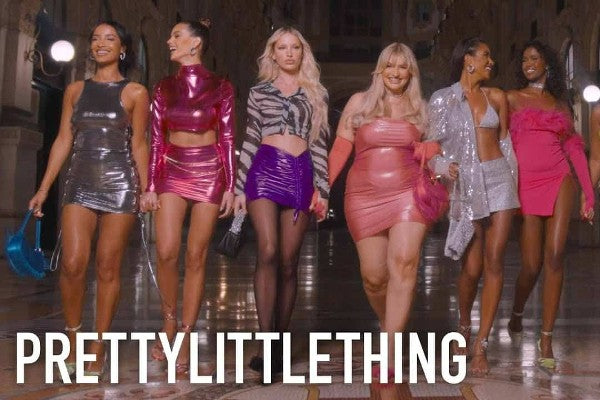-
The Essentials
The Essentials
There are no products in this collection
-
Templates
Templates
-
Services
-
The Clubhouse
-
The Clubhouse
-
The Show
-
The Show
- All Episodes
-
Marketing Tips
-
Marketing Tips
- Free Concierge Service
- Resources & Advices
- How-To's
-
The Show
-
Support
-
Support
- Business Tools
-
Customer Care
-
Customer Care
- Community Support
- FAQ
-
The Studio
-
The Studio
- Studio Locations + Hours
- Free Concierge Service
No results could be found. Please try again with a different query.
Popular items

Ep. 4: The Rebrand No One Asked For...
Beyond the flowery language, this rebrand seems to be making an attempt at luxury—or at least the illusion of it.

Let's Get To Know The Brand
PrettyLittleThing (PLT) has long been synonymous with fast fashion, offering trendy, budget-friendly pieces that cater to a young, social media-savvy audience. Think bold cut-outs, neon mini dresses, and influencer-driven collaborations. Since its launch in 2012, the brand has positioned itself as the go-to for affordable, trend-obsessed clothing that allows shoppers to keep up with the latest styles without breaking the bank.
Ep. 4: The Rebrand No One Asked For...


The Impromptu Rebrand: A New Era or an Identity Crisis?
As of March 2025, PrettyLittleThing has unveiled a surprising shift in branding, positioning itself as the epitome of ‘elevated fashion essentials.’ Their new brand messaging reads:
“Allow us to reintroduce you to PrettyLittleThing, the generation-defining style source for every kind of It Girl. With the belief that elevated fashion essentials should be available to all. From the classic and timeless to the contemporary and cutting edge, designed with you in mind. Our icon? The unicorn. Because we cater to the individual. No two people — or wardrobes — should ever be the same. This is the next era of PLT, and we’re excited to have you here with us.”
Beyond the flowery language, this rebrand seems to be making an attempt at luxury—or at least the illusion of it. And to solidify their newfound attempt at sophistication, their Instagram bio now reads: “Join the Legacy…” A phrase that suggests heritage, prestige, and, dare we say, an attempt at the ‘Old Money’ aesthetic.

The Old Money Fabrication: Does It Hold Up?
For a brand that built its empire on micro-trends and hyper-accessible fashion, the sudden pivot to legacy and timelessness feels, at best, performative. The Old Money aesthetic—characterized by quiet luxury, understated elegance, and an emphasis on quality over quantity—feels worlds apart from PLT’s previous offerings of $15 bodycon dresses and two-piece sets made for a night at the club.
But here’s the thing: Old Money isn’t just about the aesthetic—it’s about a lifestyle. It’s about generational wealth, discretion, and an aversion to anything too flashy or overly trendy. PLT, a brand that thrives on mass production and fleeting fads, attempting to align with this ethos is, frankly, ironic.
The Marketing Strategy
-
Brand Positioning
+Influencer Marketing & Events +Social Media +E-Mail Marketing +Pop-Up Experiences +Press & Media +Collaborations
-
Marketing Channels
+Influencer Marketing & Events
+Social Media
+E-Mail Marketing
+Pop-Up Experiences
+Press & Media
+Collaborations -
Marketing Pillars
+Lifestyle
+User Generated Content
+Behind The Scenes -
Shopping Experience
PLT’s shopping experience for customers are mainly from their e-commerce website and occasional pop-up experiences.
While the rebrand certainly has people talking, the real question is: Will this new identity stick? Can a fast fashion giant truly embrace the timeless, sophisticated appeal of Old Money, or is this simply a marketing gimmick designed to tap into the quiet luxury trend currently dominating fashion?
At the end of the day, PLT’s rebrand might not be the evolution it claims to be, but rather a well-calculated strategy to remain relevant in a shifting fashion landscape.
Why PrettyLittleThing’s Rebrand Flopped: A Marketing Breakdown
1. No Clear "Why"
PLT’s rebrand lacked a fundamental marketing principle: a clear reason. There was no real explanation as to why this shift was happening, what the brand hoped to achieve, or how it planned to evolve. Successful rebrands are rooted in purpose—whether to address customer needs, align with industry shifts, or improve brand perception. PLT, however, simply dropped a new aesthetic and expected customers to follow along without understanding the motivation behind it.
2. Excluding the Customer from the Process
A rebrand should feel like a conversation with loyal customers, not a one-sided announcement. PLT failed to involve its audience in the transformation, missing a crucial opportunity to gain buy-in. Had they engaged customers through polls, behind-the-scenes content, or a gradual shift rather than an abrupt overhaul, the reception might have been more positive. Instead, their audience felt blindsided by a change that didn’t align with what they loved about the brand in the first place.
3. The Identity Crisis
A strong brand identity is consistent and clear. PLT’s sudden shift from fast fashion powerhouse to ‘legacy-driven’ brand felt more like an identity crisis than an evolution. One minute, they were selling influencer-approved, trend-heavy looks; the next, they were pushing an Old Money aesthetic that contradicted their core offering. This inconsistency made the rebrand feel inauthentic, leaving customers confused about what PLT actually stood for.
4. Misaligned Product and Messaging
The essence of Old Money fashion is quality—timeless silhouettes, luxurious fabrics, and impeccable craftsmanship. Yet, PLT remains a fast fashion brand producing low-cost, mass-manufactured garments. A $25 polyester dress doesn’t suddenly become ‘legacy’ just because the marketing says so. The disconnect between their messaging and product was glaring, making the rebrand feel like an empty gimmick rather than a meaningful shift.
5. Banking on a Trend Instead of Longevity
PLT’s success has always been rooted in trend-driven fashion, but the Old Money aesthetic is just that—a trend. Attempting to shift their entire brand identity in this direction was a risky move, as trends inevitably evolve. Instead of fully committing to a fleeting aesthetic, a more sustainable strategy would have been integrating timeless elements while still catering to their core audience.
The Takeaway: Authenticity and Strategy Matter
PrettyLittleThing’s rebrand flopped because it lacked authenticity, clear communication, and customer inclusion. Rebrands should feel like a natural evolution, not a forced attempt to jump on a trend. If you’re considering a brand overhaul, make sure it’s rooted in a strong ‘why,’ engages your audience, and aligns with your product and identity.
Want expert guidance on your marketing strategy? Book a studio hour with us, or shop our marketing resources—including The Ultimate Marketing Strategy Workbook, a 59-page digital guide to building your brand from scratch.
Lately,
View all-

Stop Copying Your Competitors, You'll Always Be...
Instead, focus on what makes your brand one-of-a-kind. Stand out in a crowded market.
Stop Copying Your Competitors, You'll Always Be...
Instead, focus on what makes your brand one-of-a-kind. Stand out in a crowded market.
-
![NEW Free Concierge Service [In-Studio Only]](//www.byshaytaylor.com/cdn/shop/articles/Q2_2025_THE_MARKETING_STUDIO_CO.png?v=1743200649&width=533)
NEW Free Concierge Service [In-Studio Only]
Imagine a service that offers a luxurious, personalized shopping experience for your brand’s marketing templates. At The Marketing Studio, our Free Template Concierge Service is designed to help you navigate...
NEW Free Concierge Service [In-Studio Only]
Imagine a service that offers a luxurious, personalized shopping experience for your brand’s marketing templates. At The Marketing Studio, our Free Template Concierge Service is designed to help you navigate...
-

The Secret Ingredient Your Marketing Is Missing...
Want to create marketing that stops the scroll, sparks engagement, and actually converts? It’s time to tap into emotion.
The Secret Ingredient Your Marketing Is Missing...
Want to create marketing that stops the scroll, sparks engagement, and actually converts? It’s time to tap into emotion.
-
















































![NEW Free Concierge Service [In-Studio Only]](http://www.byshaytaylor.com/cdn/shop/articles/Q2_2025_THE_MARKETING_STUDIO_CO.png?v=1743200649&width=533)

